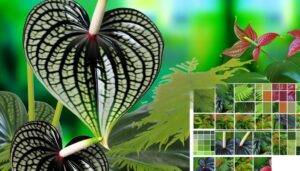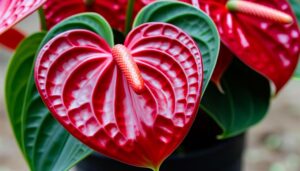3 Essential Steps to Care for Your Anthurium Hybrid
To guarantee your Anthurium hybrid thrives, place it in bright, indirect light to optimize photosynthetic efficiency without harming chlorophyll. Water when the top inch of soil is dry, using lukewarm, filtered water, and maintain ambient humidity at 60-80% to support root respiration.
Use well-aerated, organic-rich substrates like orchid bark, peat moss, and perlite for excellent drainage, and fertilize with a balanced, water-soluble fertilizer high in phosphorus. By following these steps, your Anthurium will flourish.
For further insights into advanced care techniques, consider exploring additional detailed guidance.

Key Takeaways
- Place in bright, indirect light to mimic natural tropical understory conditions.
- Water when the top inch of soil is dry using lukewarm, filtered water.
- Use well-draining organic-rich soil mixed with orchid bark, peat moss, and perlite.
- Maintain ambient humidity levels between 60-80% to support root respiration.
- Fertilize with a balanced, water-soluble fertilizer high in phosphorus, adjusting based on plant indicators.
Optimal Light Conditions
For optimal growth, place your Anthurium hybrid in bright, indirect light to mimic its natural tropical understory environment. This light condition ensures peak photosynthetic efficiency without risking leaf scorch.
Direct sunlight can harm the plant's chlorophyll, leading to photoinhibition and decreased energy production. Conversely, insufficient light can impair chloroplast function, reducing photosynthetic rates and stunting growth.
Position your Anthurium near an east or north-facing window where it receives filtered sunlight. If natural light is insufficient, use full-spectrum grow lights to provide the necessary light wavelengths.
Proper Watering Techniques
Optimizing your Anthurium hybrid receives the correct moisture levels is as important as providing the right light conditions to prevent root rot and maintain cellular turgor pressure.
Water your Anthurium when the top inch of soil feels dry. Use lukewarm, filtered water to avoid chlorine and fluoride damage. Ensure complete drainage; stagnant water triggers phytopathogenic fungi growth, leading to root necrosis.
Humidity control is vital; maintain ambient humidity around 60-80% using a humidifier or pebble tray. Avoid over-watering, which displaces essential oxygen in the rhizosphere, hampering root respiration.
Observe leaf turgidity and coloration as physiological indicators; yellowing signifies excess hydration, while wilting suggests desiccation.
Consistent moisture balance promotes optimal metabolic and photosynthetic activities, fostering robust growth.
Ideal Soil and Fertilization
Choosing the right soil mix for your Anthurium hybrid is paramount, combining well-aerated, organic-rich substrates with excellent drainage capabilities to support root health and nutrient uptake. Use a mix of orchid bark, peat moss, and perlite. This blend ensures top-notch aeration, preventing root rot while retaining moisture.
Fertilize with a balanced, water-soluble fertilizer high in phosphorus. Apply it bi-weekly during the growing season, reducing frequency in winter. Monitor for signs of nutrient deficiency, like yellowing leaves, adjusting your regimen accordingly. Avoid over-fertilizing, as excess salts can damage roots.
Conclusion
By following these three essential steps, you'll guarantee your anthurium hybrid thrives.
Give it bright, indirect light, and keep the soil moist but not waterlogged. Use a well-draining soil mix and fertilize with a balanced formula.
Keep these tips in mind, and you'll have a plant that's the picture of health. Remember, a stitch in time saves nine—consistent care prevents future plant problems.
Happy growing, and may your anthurium flourish!






